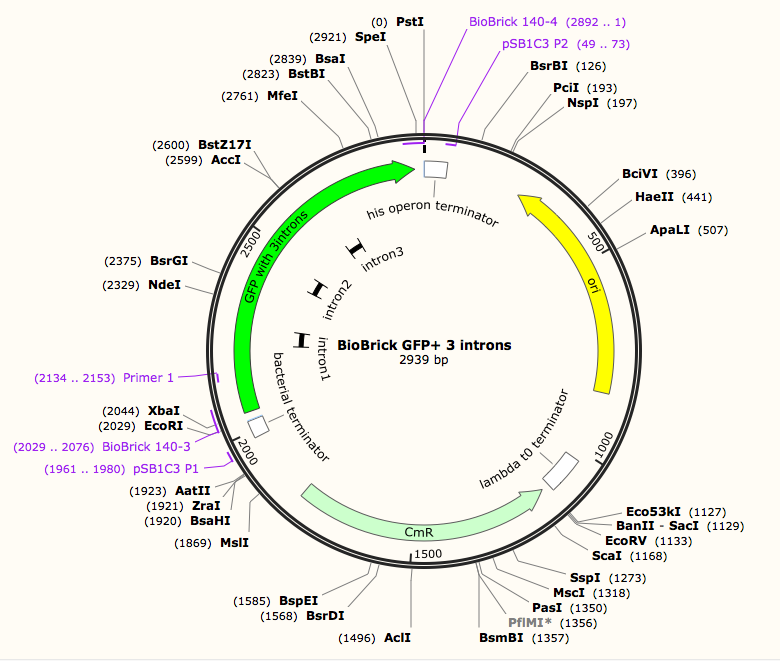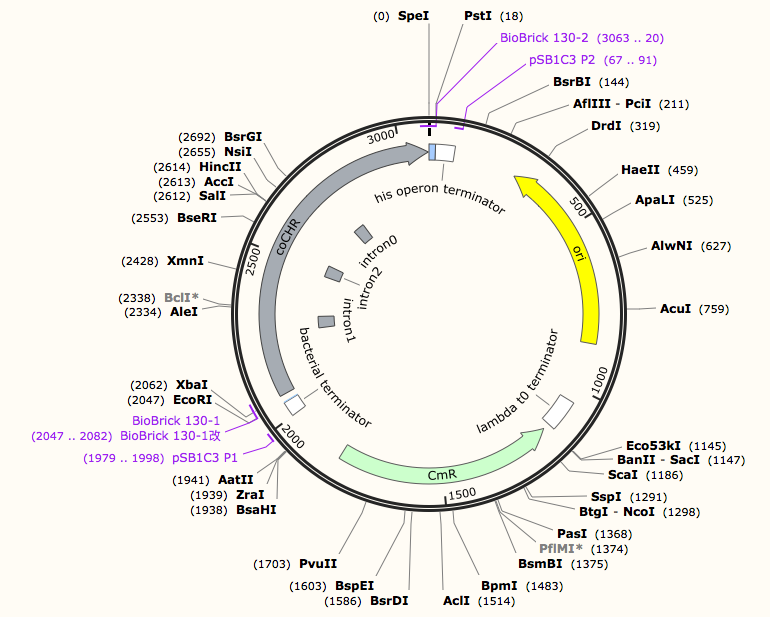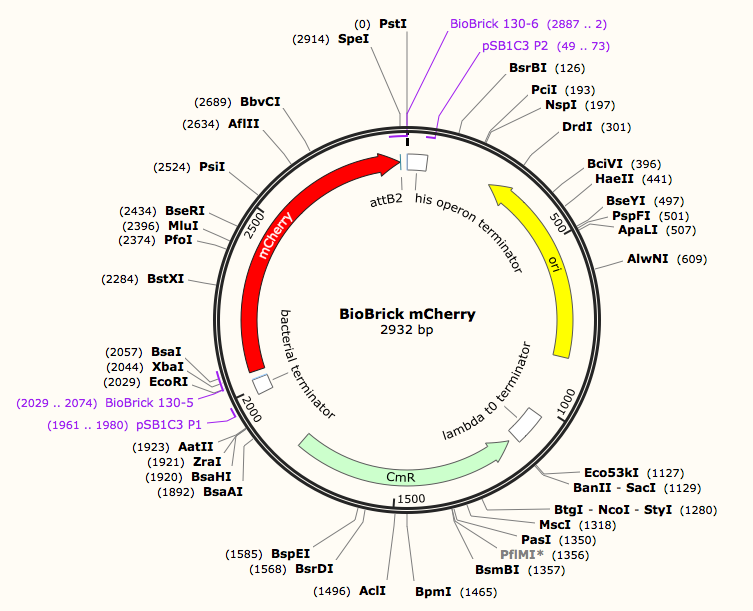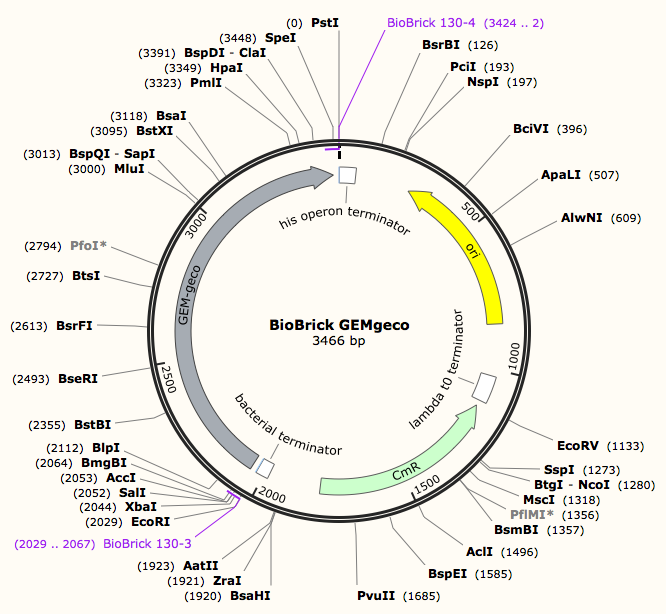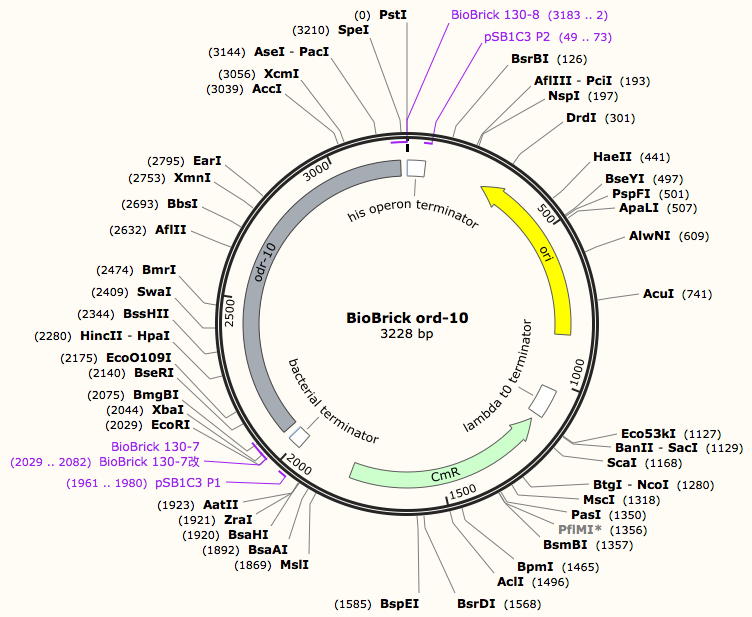Basic Parts
Contents
Part: BBa_K2492000
In short : A reporter for the visualization of transgenic neuron-AWB, it also can roughly estimate the expression level of injected plasmid.
Modified GFP with three introns which can help well expression of GFP in C.elegans. In our group, we use it to indicate the location of neuron AWB in C.elegans. We integrated podr-10::CoCHR::GEM-GECO::GFP transgene in C.elegans by microinjection. Modified GFP will be highly expressed in AWB driven by promoter str1 (no biobrick part).
Part: BBa_K2492001
In short: Part BBa_K2492001(CoCHR) provides channelrodopsin(CoCHR), which serves as a light switch. In order an part to manipulate neuron activity through ~470nm excitation light, we choose this part, which is benefit for sensitive to blue light.
It’s the central part of our project. Part BBa_K2492001 contains CoCHR(Chloromonas oogama channelrhodopsin) [1], a cation-selective light sensor, which promptly generates a large permeability of divalent cations after absorbing photons from our excitation light source.
In our project, we hope to investigate how olfactory messages are transmitted by the neuron systems. In order to decrease delay of response comparing to chemical stimulus, we choose optogenetic techniques. Since C.elegans do not have sense to light, we express channelrodopsins in pairs of neurons as light receptors. CoCHR is the channelrodopsin in transgenic AWA. In order to express CoCHR in AWA specifically, we express CoCHR through the linkage to the AWA cell-specific promoter odr-10. Thus, when we shed excitation light of around 470nm to transgenic C.elegans, the activated AWA is able to have obvious response such as body swimming towards. While wild-type C.elegans behave normally under the same stimulation. Whether the certain neuron is activated or not is indicated by GEM-GECO, a calcium indicator. In short, we established a light-sensed AWA controlling system, so as to utilize this part to manipulate the activation of AWA, establish the response to input stimulation. The merit of CoCHR is its sensitivity to light which is five-times larger than formal ChR2. Thus, the low intensity requirement prevents the cross-activation of Crimson(Chlamydomonas noctigama channelrhodopsin). Chrimson is another integrated channelrhodopsin in AWB. (Moreover, in order to indicate where the target neurons are, we also construct a fusion reporter protein called mCherry. At the same time, the fusion protein is allowed to estimate the expression level of CoCHR.)
Part: BBa_K2492002
In short: Part BBa_K2492002 codes mCherry, which indicates the position of neuron AWA. This fluorescence reporter direct reveals the position of transgenic neurons and roughly estimate the expression level of injected plasmids.
Universal mCherry coding sequence of three introns for capacity of expression in C.elegans. MCherry is a commonly used reporter. Since wild-type mCherry may not have high expression in C.elegans, artificial introns are inserted in the constructed plasmid[3]. We can obtain ord-10::Chrimson::GEM-GECO::mCherry transgenic offsprings through microinjection. MCherry driven by promoter ord-10(Part:BBa_K2492004) indicates the position of neuron AWA. Moreover the fluorescence of mCherry aids the imaging for the neuron AWA pattern. The intensity of fluorescence reveals the expression level approximately.
Part: BBa_K2492003
In short: . BBa_K2492003(GEM-GECO) is an calcium ions indicator part, it provides the function of monitoring and responding to the concentration of calcium ions. This part provides us with more direct visualisation of neuron activity.
The central part of our project. Part BBa_K2492003 contains GEM-GECO(blue-green emission ratiometric GECO附上全称?). GEM-GECO can emit green fluoresces without Ca2+ but blue fluoresces with Ca2+ [4]. GEM-GECO is used as a calcium ion indicator, so as to visualise neuron activity, such as AWA. In recent advances, calcium is a universal indicator for neuron excitation, because calcium ions are able to influx at action potential. GEM-GECO is capable of monitoring and responding to the concentration change of calcium ions due to the existence of fluorescence resonance energy transfer between two chromophores inside the functional domain. The reason for GEM-GECO enabling the response of disparate calcium ion concentration is that in the Ca2+-free state, the chromophore of this blue-green emission ratiometric GECO (GEM- GECO) undergoes excited-state proton transfer (ESPT) and emits in the lower-energy (green fluorescent) anionic form. [5], while in the calcium ions bound state, two chromophores are less compact and photon transfer is blocked, resulting in blue fluorescence.
Although we utilise CoCHR in AWA for efficient manipulation, the excited or inhibited state of neuron is not able to be obtained timely. In order to visualise whether the channelrhodopsin-CoCHR is excited or not, we integrated str1::CoCHR::GEM-GECO::GFP in C.elegans. As soon as we activate CoCHR to manipulate the neuron, GEM-GECO indicates it. For example, we use light with wavelength of 405nm to excite GEM-GECO, and receive light with wavelength of 511nm and 462nm. If calcium bound to GEM-GECO, the intensity of wavelength close to 462nm increases, indicating the neuron excitation.
As for further research, if we intended to observe the response of AWA, that is, investigating whether worm prefers or repels to certain substances, the change of fluorescence reveals the condition of AWA.
Moreover, GEM-GECO is also beneficial for the large radiometric change and it decreases the cross talk between channelrodpsin-CoCHR. And the fusion protein mCherry which is a marker for CoCHR position is also able to mark GEM-GECO due to expression linkage.
Part:BBa_K2492004
In short: Part BBa_K2492004 (Podr-10)provides an neuron AWA specific promoter which drives channelrhodopsins and calcium indicator specifically expressed in AWA.
Part BBa_K2492004 contains odr-10. It is a section of genomic DNA acting as a promoter.
In C.elegans, odr-10 encodes a large family of seven transmembrane olfactory receptor genes[6], which is specifically expressed in neuron AWA and affect chemotaxis to the volatile diacetyl. Pord-10 is a section of genemoic DNA in front of odr-10 genes promoting expression of odr-10 genes[2].
AWA is a member of the olfactory neurons [7]. It responses to attractive volatile odorants. Since we expect to express the functional channelrhodopsins and indicator in specific neuron, such as AWA, we use Podr-10 to construct the plasmid.
If CoCHR is expressed in AWA, we are capable of activating it to manipulate the state of AWA. In our project, we integrated ord-10::Chrimson::GEM-GECO::mCherry transgene to C.elegans by microinjection. Thus, CoCHR (Part BBa_K2492001:CoCHR) promoted by ord-10 is expressed in AWA. We can enhance the attraction of C.elegans through the control of AWA.
References
[1]Schild, L. C., & Glauser, D. A. (2015). Dual color neural activation and behavior control with chrimson and cochr in caenorhabditis elegans. Genetics, 200(4), 1029-34.
[2] Nagel G, Ollig D, Fuhrmann M, Kateriya S, Musti AM, Bamberg E, Hegemann P (June 2002). "Channelrhodopsin-1: a light-gated proton channel in green algae". Science 296 (5577): 2395–8. doi:10.1126/science.1072068.
[3]:S.Redemann. (2011). codon adaptation– based control of protein expression in C. elegans, Nature Methods, Vol.8 No.3 250-254.
[4]Yanli Wang et al. (2014). Excited State Structural Events of a Dual-Emission Fluorescent Protein Biosensor for Ca2+ Imaging Studied by Femtosecond Stimulated Raman Spectroscopy, The Journal of Physical Chemistry B.
[5]Yongxin Zhao et al. (2011). An Expanded Palette of Genetically Encoded Ca2+ Indicators, Science, Vol. 333, 1888-1891.
[6]:Sengupta P., Chou J.H., Bargmann C.I.Cell 84:899-909(1996)
[7]:Emily R. et al. (1997). Reprogramming Chemotaxis Responses: Sensory Neurons Define Olfactory Preferences in C. elegans, Cell, Vol. 91, 161–169.

